Iranian drone Mohajer
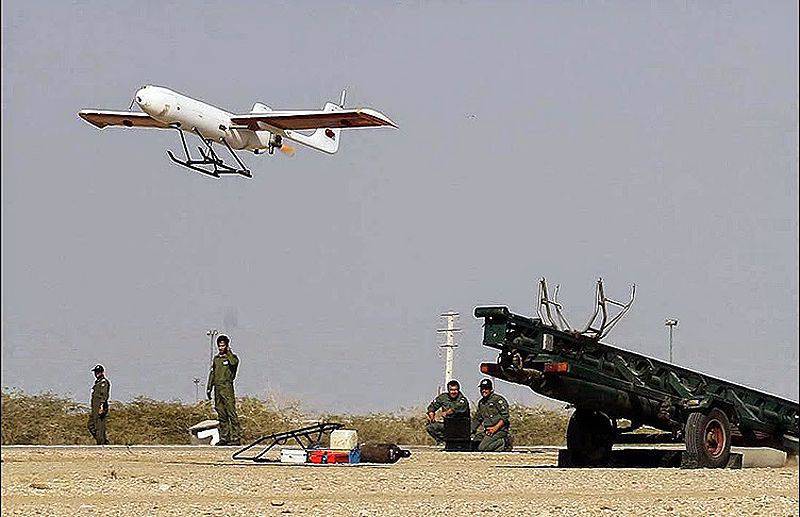
The Mohajer family includes a number of tactical drones observations, which are the most famous and technologically mature Iranian models. They were developed at the height of the Iran-Iraq war by Qods Aviation Industry and continue to be used by various branches of the Iranian armed forces. Although the drones of this family are not as common abroad as the Ababil drone, they are increasingly seen in the skies of Iraq and Syria.
The name Mohajer (Mohajer) is often translated as an immigrant or emigrant (generally migrant). But, most likely it refers to the Arabic words muhajirun and muhajir, which respectively mean the first “emigration” of the Prophet Muhammad to Mecca and those who performed the hajj.
Mohajer-1 (M1)
The Mohajer-1 drone, developed under the pressure of military circumstances, was a relatively simple design. Although it had minimal impact on the overall course of the Iran-Iraq war, the experience of combat use helped lay the foundation for further development in Iran and contributed to the development of unmanned aviation in subsequent decades.
Development
The development of the Mohajer-1 aircraft was the result of the first attempts of the Islamic Revolutionary Guard Corps (IRGC) to organize "unmanned" reconnaissance in the early 80-s. By 1985, Qods Industries was established as part of the self-sustainment department of the IRGC, which was given the task of providing the newly formed Raad brigade with UAVs. The M1 version was developed supposedly in the same year.
Technical evaluation
Seriously hampered evaluation drone M1 lack of documentation. Most of the video and photographic material about the MNNXX drones of that wartime are derived from the movie “Mohajer” released in 1 year. However, based on the attitude of the Iranian government to the creation of military films, it is reasonable to assume that the description is sufficiently accurate.
The Mohajer-1 glider is a cantilever-carrying, low-wing, double-girder, straight-wing, long elongated plan. The tail parts of each beam end with vertical tail and are connected by a stabilizer to the elevator. It is similar in size to the American RQ-7 UAV. To control the flight, the M1 drone has a rudder on a horizontal stabilizer to control the pitch angle, steering wheels on vertical stabilizers to control the yaw angle and ailerons on the wings to control the roll angle.
The three-wheeled chassis serves for take-off and landing. A parachute can also be used for return.
For surveillance, the M1 is equipped with one promising camera in the bow. Considering that it was based on other Iranian UAVs of that time, most likely it was a simple camera, the film from which it was necessary to show after returning. One of the directories claimed that he could transmit images in real time, but all this is quite controversial.
Mohajer-1 could take arms; and just in the 1990 film of the year, an apparatus is shown, which has three RPG-7 under each wing.
M1 is controlled by an amateur-class radio system (up to 100 MHz).
Application
During the Iran-Iraq war, the Raad brigade from the IRGC on the southern front was armed with an unknown number of drones. Although UAVs were used for the first time during Kheibar (February-March 1984) and Badr (March 1985) operations, the Mohajer drone is primarily associated with Valfajr-8 (February 1986) and Karbala-5 (January-February 1987) operations. These UAVs were used in the preparation of these attacks, they took photographs of the Iraqi positions. They were also reportedly used to adjust artillery fire, but it was not clear whether it was real-time or whether they were assessing the effects of shelling.
In the 1990 film of the year, two groups were shown: the rear launch squad and the advanced control squad. The need to deploy advanced observers was the result of radio control, which had limited signal power and excluded data transmission. This in turn meant that the M1 drone could be used for flying only over the front line and could not conduct reconnaissance in the depths behind the front line.
There are reports of the Iraqi military about the jamming of Iranian UAVs with the help of their VHF radio stations, which could operate on the same frequencies.
There is no evidence of how effective the M1 drone was. However, given the manual control in line of sight it is unlikely that it was too accurate. Yet in one place in this film an artistic device was used, with the aim of showing the aim in real time using an onboard camera. In addition, according to some reports, these weapons were tested as anti-ship weapons in the Persian Gulf.
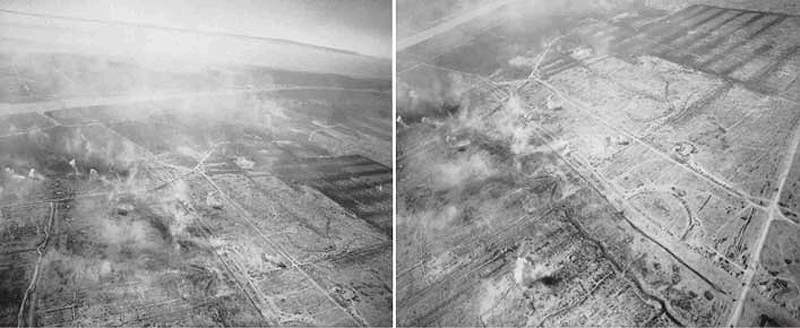
Shooting the results of the shelling during the operation Karbala-5
Mohajer-2 (M2)
Mojajer-2 is a typical representative of the intermediate generation of Iranian drones, developed in the 90-s of the last century. In this regard, it is by and large equivalent to Ababil-2, regarding generation and characteristics (for example, maximum take-off weight, flight duration). However, unlike the Ababil, the M2 UAV is still regularly used for reconnaissance purposes. Although its capabilities are very modest compared to the current generation of UAVs, upgrades will keep the M2 in the ranks.
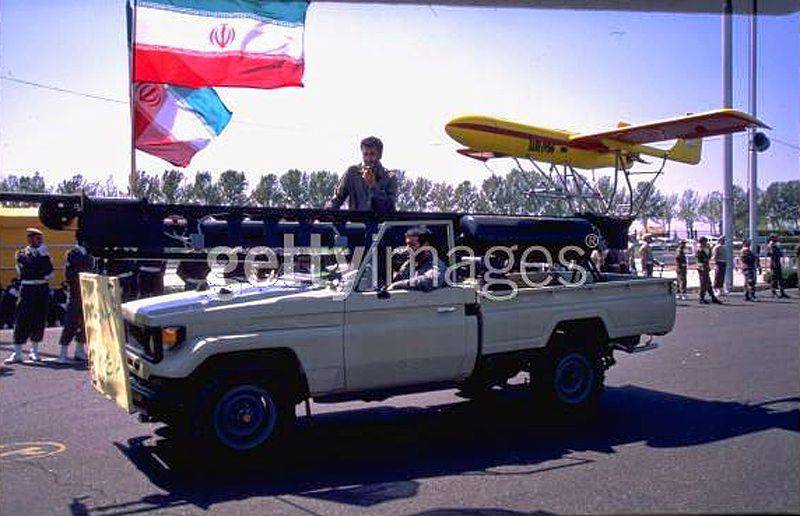
Parade in 1996 year
Development
Mohajer-2 was developed before 1996, since this year it took part in the parade in Tehran. Later in 1999, Qods announced that it was organizing a demonstration flight in conjunction with Mohajer 3 and 4 (although this flight does not exist). M2 was next shot at an air show in Kishe in 2005. Since then, the M2 UAV and its variants regularly hit the camera lens.
In the middle of the 2000's, the 253 of the Mohajer drone was manufactured. Although it is impossible to say how much falls on the M2 model, it is reasonable to assume that they constitute the majority of this quantity.
In November, a new generation drone M2014 with significantly improved performance was shown at the air show in Kirsch.
Technical ratings
The construction of the Mohajer-2 airframe is a development of the Mohajer-1 project. It is characterized by the same cylindrical fuselage, two-tail tail and straight wings. The control system of the device is the same: the elevator on the horizontal stabilizer to control the pitch angle, the rudders on the vertical stabilizers to control the yaw angle and the flaps on the wings to monitor the roll angle. Small variations on the M2 version, such as a modified engine cover, suggest small design changes.
Using a ski chassis instead of the M1 drone's three-wheeled chassis means that the M2 variant depends on a pneumatic or jet accelerator (usually the first of the two). Return either by parachute or traditional landing.
On the Mohajer-2 there is a two-cylinder piston engine WAE-342 with horsepower 26 hp. with the pushing propeller, which is also used on Iranian AB2 and Saeqeh UAVs. However, a small number of models have atypical exhaust systems, possibly explaining the discrepancy between the well-known 342 engine power and consistently promoted in the M2 brochures of the 25 hp power. The official ad refers to the range of 50 km (100 km ferry distance) and the duration of the flight 1,5 hour.
Each wing of the M2 unit is equipped with one whip antenna. They provide communication channels at a higher frequency (up to 10 GHz), which allows real-time monitoring. As for the Ababil family, the lack of long-range control is most likely not a particular problem, given its small range of these devices. Although there is very little accurate information, export prospectuses say that it is integrated with control software that allows Mohajer to fly in one of three modes: manual, semi-automatic and automatic.
- Manual: The operator controls all the parameters of the flight of the drone using the data from the onboard cameras in real time. In this mode, communication channels with high and low bandwidth between the drone and ground control station are necessary.
- Semi-automatic: The operator determines the flight route of the UAV, but does not control the flight itself. This mode relies on a low-bandwidth channel and a telemetry channel, which have a longer range than channels with higher frequencies used to transfer images from a drone.
- Automatic: the UAV follows the predetermined flight route and executes commands using the coordinates of the satellite and inertial navigation systems. This mode does not require any communication channels between the UAV and the control station.
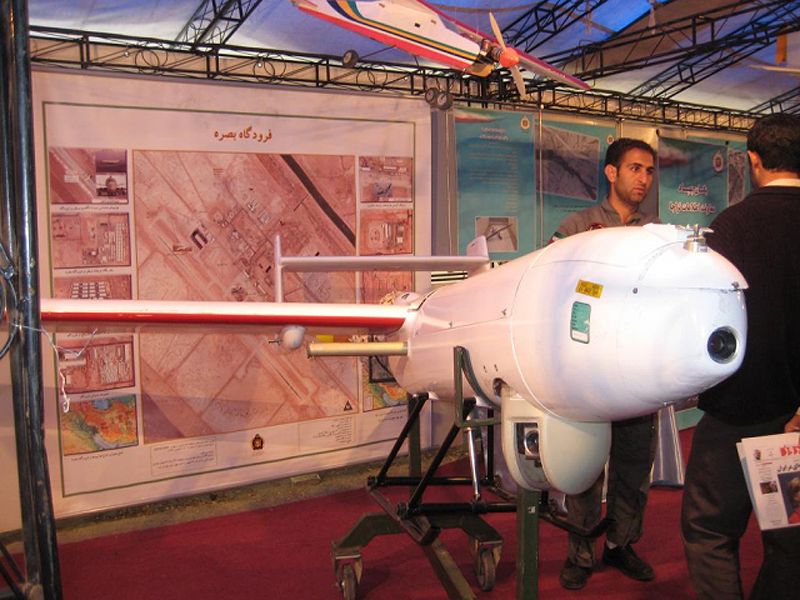
Land Force Exhibition in 2009. Front camera and viewport optical station
The Mohajer-2 drone can take on board three different species-specific optical intelligence systems: a) a versatile search hinge optical-electronic system, b) a fixed downward-looking camera for aerial surveillance and c) a fixed forward-looking camera in the nose to perform the flight itself. The universal joint system is used for real-time monitoring, but due to the relatively small carrying capacity of the M2 variant, only light models can be installed. In practice, only daily cameras, such as IEI's Oghab 11, were installed. The first batches of the first batch of M2 drone had no forward-looking camera
Prospectuses describing the drone M2, also advertise the use of laser devices with linear scanning (for aerial photography of large areas) and unspecified electronic warfare equipment. Neither was documented.
Like the M1 variant, the M2 drone can also be armed. Experimental models with two six-barrel grenade launchers are demonstrated on documentary shots. However, evidence of their real use does not exist.
M2 specifications
Length: 2,91 m
Wingspan: 3,8 m
Empty weight: 70 kg
Cargo weight: 15 kg
Maximum takeoff weight: 85 kg
Maximum speed: 200 km / h
Ceiling: 3350 m
Flight radius: 50 km
Flight duration: 90 minutes
Engine: 25 HP L-275
M2N specifications
Length: 2,90 m
Wingspan: 3,82 m
Maximum takeoff weight: 90 kg
Maximum speed: 180 km / h
Range: 150 km
Flight duration: 6 hours
options
Raad-85
According to some data (with low and medium degree of confidence), the Raad-85 is a shock version of the “kamikaze” drone M2; it can be compared with the similarly equipped version of the aircraft Ababil-2. In particular, the designation Raad-85 may be associated with ground forces of the Iranian army.
The first mention of Raad appeared in February 2011, when then-Secretary of Defense Vahidi announced the production of an offensive UAV capable of high-precision attack. Later in October, 2011, the agency Mashregh News, described Raad as a variant of the Saeqeh unmanned target (also produced by the Qods Company). Although there was no reason for such a statement, and at first glance it seems to be a product of the news agency’s own research, this information cannot be discounted. The most vivid evidence of Raad's connection with the M2 drone was the XIRP Great Prophet 8 drills in February 2013, during which the drone based on the M2 as a striking "suicide" was demonstrated.
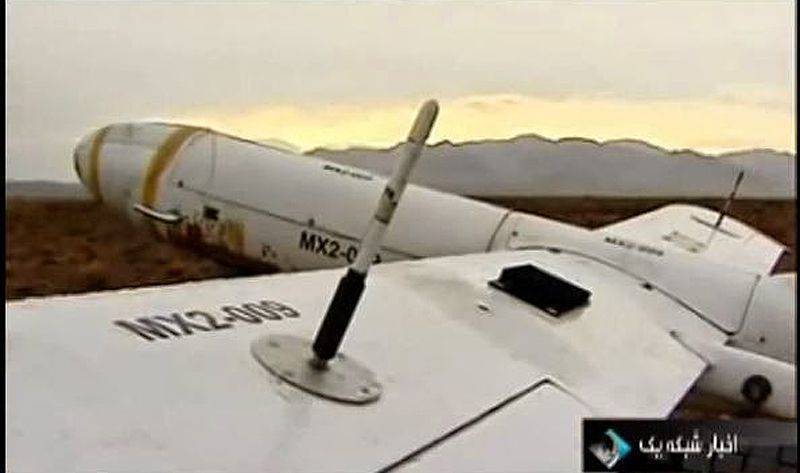
"Drone-suicide" based on the M2 apparatus during preparation for takeoff during the 2013 exercise year
Finally, during the hand-over ceremony in September 2013, it was announced that the army was manufacturing Raad-85 in collaboration with the Qods Company. At the ceremony, drones M2 and Saeqeh were presented without any further clarification.
The characteristics of the Raad drone are not very clear and reliable. In September 2013, the ground commander announced that Raad has an 100 km range (the same as the M2). Then, during the 2014 exercise in December, another commander reported that Raad has an 250 km range, hinting more closely with M2N than with M2 or Saeqeh, which have a much smaller range.
Mohajer-2N
M2N (N means new - new) was shown at the Kish Airshow in 2014. In appearance, it is almost identical to the M2 drone, but reportedly has significantly higher performance. These include an increase in flight range by 200% (from 50 km to 150 km) and an increase by 300% flight duration (from 1,5 to 6 hours). It is also reported that he is capable of carrying missile launchers under his wings. Although these features still need to be documented, it seems likely that it can carry any weapons that the M2 and M4 options described in this article can accept.
It is not entirely clear what caused such an increase in the range and duration of the M2N variant. The most likely explanation is the addition of fuel tanks to the wings, which also had negative consequences regarding mass restrictions (a modest increase in maximum take-off weight per 5 kg).
At the air show in Kirsch, the poster showed a M2N drone with wheeled chassis, although the exhibition model was shown with a traditional ski chassis.
M2N drone on Kish 2014 airshow
Application
In Iran, Mohajer-2 is in service with the army and the IRGC and is used to monitor and conduct attacks. However, documentary evidence of its use by the IRGC is very rare, only exercises or parades, which leads to the conclusion that most of them are in service with the army. Much of the army drone M2 was filmed in its ground units.
In service with land forces, it is used to conduct reconnaissance and surveillance in conflicts of high and low intensity. In conflicts with high intensity, they are organized into UAV divisions or within already formed divisions for conducting intelligence at the corps level. Working in low-intensity conflicts involves day-to-day border surveillance in support of ground operations, much like a large number of army helicopters are already operating. They are also used for non-military tasks, for example, when the army is mobilized for natural disasters: during floods, earthquakes, or snowstorms.
As expected, the Raad-85 will go into service with the ground forces in 2015 according to the results of the first tests that were carried out during the army exercises in December 2014. After entering service with the UAV Raad will carry out long-range strike missions. This puts him on a par with rocket artillery (for example, Nazeat and Zelzal), which itself is a powerful force at the national level with a similar range (approximately 100-300 km). In addition, the ground forces are the only branch of the armed forces that will have the suicide bomber armament, further widening the conceptual gap between the Raad and, for example, high-precision guided munitions of the Air Force or anti-ship cruise missiles fleet.
In addition to the army, the shock version was filmed in February 2013 of the year during the IRGC exercises under the designation Great Prophet 8.
Export
In addition to Iran, the Mohajer-2 drone is in service with the Venezuelan Air Force, where it is known by the local designation Arpia (Harpy). They are assigned to the 83-I UAV squadron, which is part of the 8-I aviation group, based at the El Libertador airbase in the city of Maracay.
Venezuela’s purchase of M2 drones began in 2007, when an agreement was signed with Iran for the production of UAVs. By 2009, the state-owned company CAVIM began assembling them from vehicle sets supplied from Iran. They were first shown to the public in June 2012. By June 2013, CAVIM manufactured 15 units. Three reportedly suffered a catastrophe, i.e. 12 devices remained in service. In addition, an unknown quantity was supplied to the state oil company PDVSA for pipeline inspection.
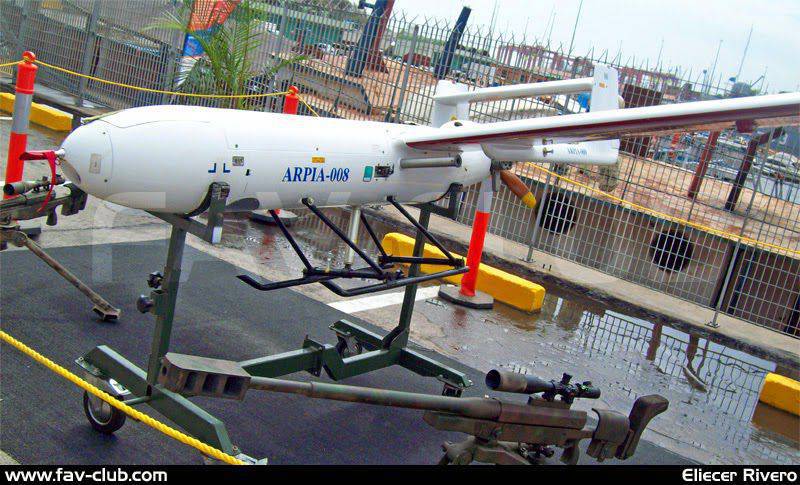
Middle Plan Venezuelan drone Arpia
In addition to Venezuela, there are several reports of the appearance of Mohajer-2 in the sky of Syria. However, low quality images are available and M2 cannot be clearly identified from them.
Features:
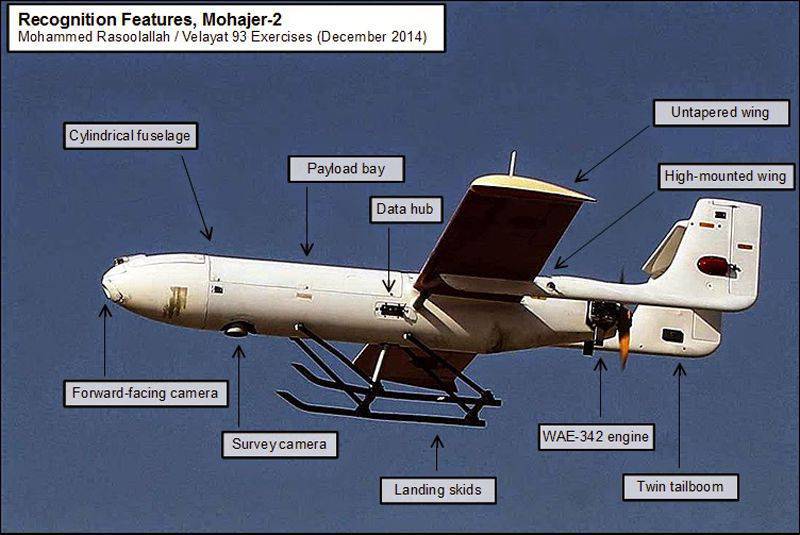
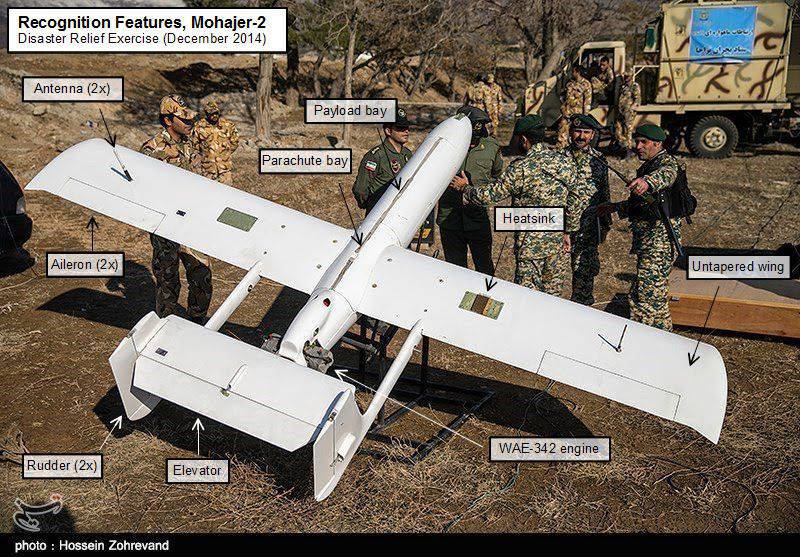
Mohajer-3 (M3) (Dorna)
Development
The first documentary evidence of the existence of the Mohajer-3 variant appeared in the 1999 year, that is, it was allegedly developed in the middle of the 90-s. Apparently, the purpose of its creation was to increase the duration of the flight compared to the M2. Serial production of the new device did not start, and soon its place was taken by the Mohajer-4 version.
The M3 variant is sometimes called the Dorna, which means the crane.
Technical specifications
The Mohajer-3 is a significant development compared to the Mohajer-2 and is distinguished by a wider, square cross-section fuselage and rear-mounted tail section.
Features
Speed cruising: 180 km / h
Range: 100 km
Flight duration: 2-3 hours
Application
On the combat use of drone Mohajer-3 no data.
Features:
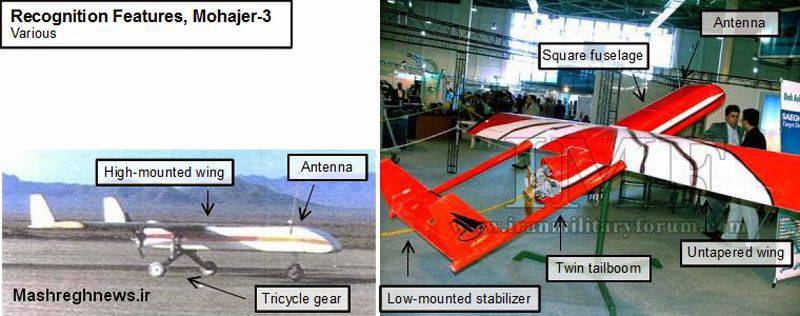
Mohajer-4 (M4) Option (Hodhod / Shahin)
Development
The new drone Mohajer-4 was first mentioned in the press in 1999, when it was discussed along with the M2 and M3 options. The first photo was published in 2003 year, but it is possible earlier. By the middle of the 2000, 34 drone M4 (19 in 2005 and 15 in 2006) was manufactured out of the total 253 of the Mohajer-1 / 2 / 3 / 4 X-gun.
The new generation M4 was shown in September 2014 of the year, but it still has to take the place of the current generation of drones.
M4 is sometimes called Hodhod or Shahin. Hodhod is a crested hoopoe living, including in Asia, and which is present in Persian mythology. Shahin means falcon. These designations will be discussed below.
Technical evaluation
Mohajer-4 continues the evolutionary path of the M2 and M3 models. Its larger size and aerodynamic improvements reflect the goals set before the developers: increased range and duration of the flight.
The M4 airframe is characterized by a) a square fuselage in cross section and b) wings with pointed rear edges, curved wing tips and a streamlined root glide of the wing. The control surfaces are the same and include the elevator on the horizontal stabilizer, the rudders on the vertical stabilizers and the ailerons on the wings.
Although different engines were installed on a number of earlier models, currently the four-cylinder Limbach L4 hp 550 hp engine is currently installed uniformly on the Mohajer-50. with the pusher propeller. UAVs with other engines, as a rule, are painted in bright colors and there are no markings on them, whence it can be assumed that these are prototypes owned by Qods Company. On one of them was installed an unknown four-cylinder engine with a carburetor that looks like a WAE-342 drone engine. On the other was installed rotary-piston engine AR-741 38 horsepower. The reason for choosing the L550 engine is unknown and may be caused by special circumstances, such as accessibility. It can be assumed that L550 - despite the large mass and fuel consumption (two times more than that of the AR-741) - was chosen, first of all, because of its power, which allows us to take more fuel on board.
UAV Mohajer-4 is equipped with two antennas, usually located at the top of the compartment with electronic equipment. Although the features of the system are little known, it is safe to talk about the same three flight modes as in the M2 variant described above. Since the M4 has a greater payload and a more powerful on-board power supply, it is reasonable to assume that its range of control has slightly increased.
The M4 version can accept three different sets of on-board equipment: a) a fixed forward-looking camera at the bow for navigation, b) an optical-electronic station for optical species reconnaissance, or c) a fixed down-facing camera for aerial photography. The current generation M4 can carry either a station on a universal joint or an aerial camera, but not both. In practice, use of only day chambers has been confirmed. However, the next generation drone M4 (described below) can carry both systems at the same time; It was demonstrated with a multi-channel photo camera. But even if all of these cameras and camcorders were deployed immediately, their relatively simple design and delayed work contrasts with more sophisticated equipment installed in similar-sized AB3 drones.
In 2014, the Ministry of Defense announced that M4 could carry two portable QW-1 anti-aircraft missile systems. The principle of operation of these QW-1 is the same as on earth. The operator aligns the launch tube with a target using on-board cameras, and then the own infrared homing missile captures the target. Although it is easy to see the scope of this weapon, for example, the shelling of a single helicopter, which is a tasty prey, the addition of this system did not contribute to the transformation of the Mohajer into a specialized interceptor.
Characteristics (Mohajer-4 *)
Length: 3,64 m
Wingspan: 5,30 m
Mass, maximum take-off: 175 kg
Max. speed: 180 km / h
Flight duration: 3-5 hours
Ceiling: 4500 m
Range: 150 km
* Characteristics are given for a drone with an unknown engine.
Features (Hodhod A / 100 *):
Length: 3,74 m
Wingspan: 5,3X m (where x = 2, 3 or 4)
Max. take-off weight: 210 kg
Speed: 200 km / h
Flight duration: 3 hours
Ceiling: 4500 m
Range: 150 km
* With rotary piston engine. The description is given below.
options
Hodhod A / 1 [A / 100]
It is not clear that the designation Hodhod is used for a special variant with unique characteristics or for some other variant. One plausible explanation is that this name used the IRGC, while another explanation is that this version of the drone M4 differs in several other technical parameters.
Two special cases were documented:
The first. In September 2010, the designation was given to an exhibition model equipped with an AR-741 engine, which was painted in bright red and white colors. The corresponding poster, issued by the IRGC, presented unique characteristics that differed from those usually attributed to the M4 version. More specifically, it was stated that the Hodhod is slightly longer than the M4 variant, has a slightly larger wingspan, greater take-off weight and possibly shorter flight time. Since these differences do not fit with the use of the AR-741 engine instead of the more powerful L550, it is reasonable to assume that the designation “Hodhod” does not apply to the variant with this engine.
Second. At the September parade were shown two drone M4, which are in service with the IRGC. These two vehicles were identical to other M4 drones, with the exception of a unique serial number and possibly a new ventral compartment for equipment. Unlike the model described in the first case, they are equipped with the L550 engine and they do not have the index “A / 1” or “A / 100” in their designation.
Shahin
As in the case of Hodhod, it is unclear whether the designation “Shahin” refers to a separate variant, or whether this is a special designation given to the IRGC.
This designation was first applied to the army drone M4 on the parade 2010 year. In October 2013, in the same media, it was mentioned as a special version of M4, it was also suggested that this is a specific designation of the army. This source also noted that the maximum Shahin take-off mass is 230 kg, which is higher than the M4 take-off weight in most descriptions.
Sadiq / Mohajer-4B
Sadiq or Mohajer-4B is a highly developed M4 platform. A new version was shown at the defense exhibition in August 2014. There are no technical specifications for this option in the public domain.
There is some uncertainty regarding the designation, since they were shown as two projects of the Ministry of Defense (aerial photography and air defense weapons). However, based on the parallel use of on-board armament and equipment on the current generation M4, it is reasonable to assume that the M4B model is a separate development. It is possible that the designation "Sadiq" may refer to any drone M4 with special equipment for aerial photography.
External distinguishing features of Mohajer-4B:
- New ski chassis
- Wings installed in the middle of the fuselage; curved wing tips removed; perhaps a larger wingspan.
- A new form of the fuselage to improve the aerodynamic characteristics of the nose and improved engine cooling.
- The enlarged cargo compartments can now simultaneously receive a specific reconnaissance station and a downward pointing camera.
- Undefined payload can be placed in a new compartment at the bottom of the fuselage.
Application
In Iran, the M4 drone is in service with the army and the IRGC; he performs reconnaissance missions in low and high intensity conflicts. In the Army, they are known as Shahin and appear to be organized in the same way as M2 drones. Ground units use M4 units from at least 2010 onwards, and in the fall of 2013, they received a significant number of these UAVs, stating that they would use them to guard borders. In November 2014, one of the M4 UAVs that had previously participated in the parade (number A041-112) was shot down by an Islamic state during a reconnaissance flight in the skies of Iraq. It is noteworthy that a tail boom from another set was installed on this drone, which illustrates the modular concept of the M4 project.
Although their use was not confirmed by the Air Force, the Navy, or Iranian air defense, the M4 drone took part in the Velayat-89 drills in the Persian Gulf in 2010, which are usually conducted by the Iranian Air Force and Navy.
These drones are also used by the IRGC to monitor the sea, as evidenced by several IRGC video clips, in which the M4 UAVs remove the passage of warships through the Strait of Hormuz. In addition, the IRGC uses them in security missions in the areas of Sistan and Baluchistan along with its UAPS, Shahed.
Export and application abroad
In addition to Iran, these drones were seen and removed in the skies of Iraq and Syria, although it is not always clear who controlled them. Since 2012, several vehicles have been seen in Syria, but it is possible that they were confused with the more common AB3 drones. However, the drone M4B was shot down over the city of Deir ez-Zor in January 2015, and then restored.
In Iraq, in addition to the ground forces described above, the M4 UAV was killed, at least two more drone M4 were lost. The first was shot down near the city of Samarra in July 2014 of the year, several images of the Iraqi flag were painted on it. The second drone, the M4, was shot down near the city of Kirkuk in January 2015, and there were no identification marks on it.
Features:
Materials used:
www.spioenkop.blogspot.ru
www.thearkenstone.blogspot.ru
www.en.wikipedia.org
www.ru.wikipedia.org

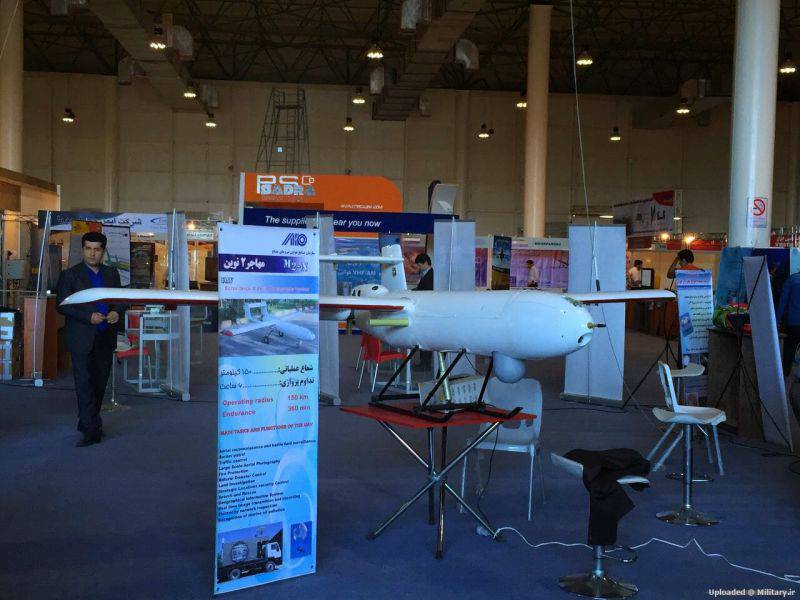
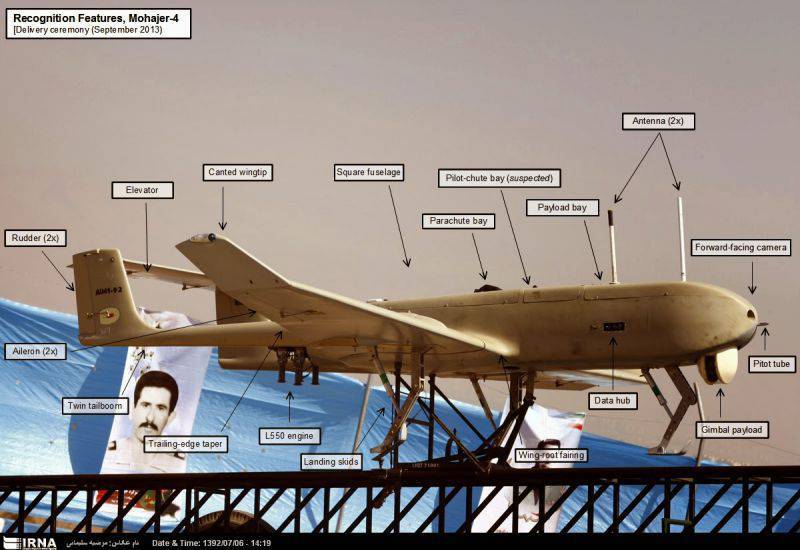
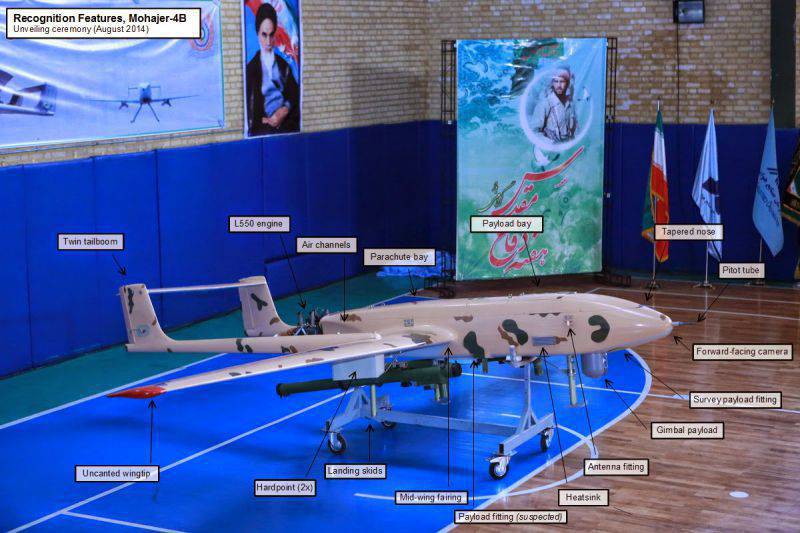
Information